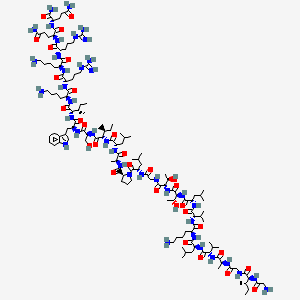m6A-centered Drug Response Information
General Information of the Drug (ID: M6ADRUG0098)
| Name |
Melittin
|
||||
|---|---|---|---|---|---|
| Synonyms |
Melittin; 20449-79-0; Forapine; Honeybee melittin; Bee venom melittin; Forapin; Melitten; UNII-24VT8NVE75; 24VT8NVE75; CHEBI:6736; Melittin I; MFCD00076868; Melittin (apis cerana); L-Glutamamide, glycyl-L-isoleucylglycyl-L-alanyl-L-valyl-L-leucyl-L-lysyl-L-valyl-L-leucyl-L-threonyl-L-threonylglycyl-L-leucyl-L-prolyl-L-alanyl-L-Leucyl-L-isoleucyl-L-seryl-L-tryptophyl-L-isoleucyl-L-lysyl-L-arginyl-L-lysyl-L-arginyl-L-glutaminyl-; GIGAVLKVLTTGLPALISWIKRKRQQ-NH2; CHEMBL412927; AKOS024456456; Melittin, >=97% (HPLC), synthetic; RS-2008; NCGC00167171-01; AC-32561; Honey Bee Venom Extract ~ 70% Melittin; XM176021; Melittin (GIGAVLKVLTTGLPALISWIKRKRQQ-amide); Melittin from honey bee venom, >=65% (HPLC); Melittin from honey bee venom, >=85% (HPLC); G-I-G-A-V-L-K-V-L-T-T-G-L-P-A-L-I-S-W-I-K-R-K-R-Q-Q-NH2; Gly-Ile-Gly-Ala-Val-Leu-Lys-Val-Leu-Thr-Thr-Gly-Leu-Pro-Ala-Leu-Ile-Ser-Trp-Ile-Lys-Arg-Lys-Arg-Gln-Gln-NH2; Gly-L-Ile-Gly-L-Ala-L-Val-L-Leu-L-Lys-L-Val-L-Leu-L-Thr-L-Thr-Gly-L-Leu-L-Pro-L-Ala-L-Leu-L-Ile-L-Ser-L-Trp-L-Ile-L-Lys-L-Arg-L-Lys-L-Arg-L-Gln-L-Gln-NH2; glycyl-L-isoleucylglycyl-L-alanyl-L-valyl-L-leucyl-L-lysyl-L-valyl-L-leucyl-L-threonyl-L-threonylglycyl-L-leucyl-L-prolyl-L-alanyl-L-leucyl-L-isoleucyl-L-seryl-L-tryptophyl-L-isoleucyl-L-lysyl-L-arginyl-L-lysyl-L-arginyl-L-glutaminyl-L-glutamamide; H-Gly-Ile-Gly-Ala-Val-Leu-Lys-Val-Leu-Thr-Thr-Gly-Leu-Pro-Ala-Leu-Ile-Ser-Trp-Ile-Lys-Arg-Lys-Arg-Gln-Gln-NH2
Click to Show/Hide
|
||||
| Status | Investigative | [1] | |||
| Structure |
 |
||||
|
3D MOL
|
|||||
| Formula |
C131H229N39O31
|
||||
| InChI |
InChI=1S/C131H229N39O31/c1-23-71(16)102(163-97(176)60-135)122(194)146-62-98(177)148-74(19)109(181)164-100(69(12)13)124(196)160-88(55-65(4)5)116(188)155-84(41-30-33-51-134)115(187)165-101(70(14)15)125(197)161-90(57-67(8)9)118(190)168-106(77(22)173)128(200)169-105(76(21)172)123(195)147-63-99(178)150-92(58-68(10)11)129(201)170-54-36-44-94(170)121(193)149-75(20)108(180)158-89(56-66(6)7)117(189)166-104(73(18)25-3)127(199)162-93(64-171)120(192)159-91(59-78-61-145-80-38-27-26-37-79(78)80)119(191)167-103(72(17)24-2)126(198)157-83(40-29-32-50-133)111(183)154-85(42-34-52-143-130(139)140)112(184)152-82(39-28-31-49-132)110(182)153-86(43-35-53-144-131(141)142)113(185)156-87(46-48-96(137)175)114(186)151-81(107(138)179)45-47-95(136)174/h26-27,37-38,61,65-77,81-94,100-106,145,171-173H,23-25,28-36,39-60,62-64,132-135H2,1-22H3,(H2,136,174)(H2,137,175)(H2,138,179)(H,146,194)(H,147,195)(H,148,177)(H,149,193)(H,150,178)(H,151,186)(H,152,184)(H,153,182)(H,154,183)(H,155,188)(H,156,185)(H,157,198)(H,158,180)(H,159,192)(H,160,196)(H,161,197)(H,162,199)(H,163,176)(H,164,181)(H,165,187)(H,166,189)(H,167,191)(H,168,190)(H,169,200)(H4,139,140,143)(H4,141,142,144)/t71-,72-,73-,74-,75-,76+,77+,81-,82-,83-,84-,85-,86-,87-,88-,89-,90-,91-,92-,93-,94-,100-,101-,102-,103-,104-,105-,106-/m0/s1
|
||||
| InChIKey |
VDXZNPDIRNWWCW-JFTDCZMZSA-N
|
||||
| PubChem CID | |||||
Full List of m6A Targets Related to This Drug
Neurogenic locus notch homolog protein 2 (NOTCH2)
| In total 1 item(s) under this target gene | ||||
| Experiment 1 Reporting the m6A-centered Drug Response by This Target Gene | [2] | |||
| Response Summary | METTL3 acts as a fate determinant that controls the sensitivity of bladder cancer cells to melittin treatment. Moreover, METTL3/miR-146a-5p/NUMB/Neurogenic locus notch homolog protein 2 (NOTCH2) axis plays an oncogenic role in bladder cancer pathogenesis and could be a potential therapeutic target for recurrent bladder cancer treatment. | |||
| Responsed Disease | Bladder cancer | ICD-11: 2C94 | ||
| Target Regulator | Methyltransferase-like 3 (METTL3) | WRITER | ||
| Target Regulation | Down regulation | |||
| Cell Process | miRNA maturation | |||
| Cell apoptosis | ||||
| In-vitro Model | T24 | Bladder carcinoma | Homo sapiens | CVCL_0554 |
| SV-HUC-1 | Normal | Homo sapiens | CVCL_3798 | |
| EJ (Human bladder cancer cells) | ||||
| BIU-87 | Human bladder cancer cells | Homo sapiens | CVCL_6881 | |
| In-vivo Model | For melittin treatment study, 4-week-old female BALB/c nude mice were subcutaneously injected with 1 × 107 T24 or BIU87 cells. | |||
Protein numb homolog (NUMB)
| In total 1 item(s) under this target gene | ||||
| Experiment 1 Reporting the m6A-centered Drug Response by This Target Gene | [2] | |||
| Response Summary | METTL3 acts as a fate determinant that controls the sensitivity of bladder cancer cells to melittin treatment. Moreover, METTL3/miR-146a-5p/Protein numb homolog (NUMB)/NOTCH2 axis plays an oncogenic role in bladder cancer pathogenesis and could be a potential therapeutic target for recurrent bladder cancer treatment. | |||
| Responsed Disease | Bladder cancer | ICD-11: 2C94 | ||
| Target Regulator | Methyltransferase-like 3 (METTL3) | WRITER | ||
| Target Regulation | Down regulation | |||
| Cell Process | miRNA maturation | |||
| Cell apoptosis | ||||
| In-vitro Model | T24 | Bladder carcinoma | Homo sapiens | CVCL_0554 |
| SV-HUC-1 | Normal | Homo sapiens | CVCL_3798 | |
| EJ (Human bladder cancer cells) | ||||
| BIU-87 | Human bladder cancer cells | Homo sapiens | CVCL_6881 | |
| In-vivo Model | For melittin treatment study, 4-week-old female BALB/c nude mice were subcutaneously injected with 1 × 107 T24 or BIU87 cells. | |||
hsa-miR-146a-5p
| In total 1 item(s) under this target gene | ||||
| Experiment 1 Reporting the m6A-centered Drug Response by This Target Gene | [2] | |||
| Response Summary | METTL3 acts as a fate determinant that controls the sensitivity of bladder cancer cells to melittin treatment. Moreover, METTL3/hsa-miR-146a-5p/NUMB/NOTCH2 axis plays an oncogenic role in bladder cancer pathogenesis and could be a potential therapeutic target for recurrent bladder cancer treatment. | |||
| Responsed Disease | Bladder cancer | ICD-11: 2C94 | ||
| Target Regulator | Methyltransferase-like 3 (METTL3) | WRITER | ||
| Target Regulation | Up regulation | |||
| Cell Process | miRNA maturation | |||
| Cell apoptosis | ||||
| In-vitro Model | T24 | Bladder carcinoma | Homo sapiens | CVCL_0554 |
| SV-HUC-1 | Normal | Homo sapiens | CVCL_3798 | |
| EJ (Human bladder cancer cells) | ||||
| BIU-87 | Human bladder cancer cells | Homo sapiens | CVCL_6881 | |
| In-vivo Model | For melittin treatment study, 4-week-old female BALB/c nude mice were subcutaneously injected with 1 × 107 T24 or BIU87 cells. | |||
References